Last weekend from February 24 to 27, the Lenfest Center for the Arts presented the comedy Der Ring Gott Farblonjet, an MFA directing thesis from current student Phoebe Brooks. Deputy Events Editor and Ring Cycle enthusiast Ava Slocum attended the Saturday matinee of this vastly abridged parody of Richard Wagner’s four-opera saga.
I never know quite how to say that I love Wagner, considering his racism, bigotry, and general pre-Nazi-ism that made him a source of controversy even when he was composing back in the mid-1800s. But I really do adore his music—if not the man himself—and after spending much of the quarantine year listening to various Ring Cycle recordings from opera houses around the country, I was so excited to see the Lenfest Center’s in-person production of Charles Ludlam’s 1977 Ring parody Der Ring Gott Farblonjet, the directing thesis of Columbia MFA student Phoebe Brooks. Brooks’s direction carefully and subtly evoked some elements of the issues that make it important to continually reassess our relationship with Wagner and his music while bringing out all the wacky, dramatic, and over-the-top moments that make the Ring Cycle a delight to parody in Ludlam’s goofy (and very abridged) two-hour version.
The jokes started before the audience even made it into the theater. The Lenfest Center, very fancily, had an elevator man who pushed the button up to the fourth-floor theater with the small crowd in tow. Two ushers bearing programs showed us to our seats–but just minutes into the show came an announcement from the stage manager that the theater workers (actors in disguise all along) would collectively be playing every character across all four operas.
The show’s absurd hilarity continued into its first segment, a spoof of the Ring’s first opera Das Rheingold. After the initial chaos of the sudden “update in casting,” the slapsticky backstage shouts of “help!” and “why can’t I find my costume?” eventually merged into cast-wide humming that ultimately transitioned into the opening chords of Das Rheingold’s vorspiel. The Rhinemaidens appeared onstage with Ariel-reminiscent flowers in their hair and mermaid bikini tops, followed soon after by Wotan and Fricka in handmade plastic crowns. Actor James La Bella (the guy from the elevator) stole the show in his dual roles as Fricka and Flosshilde. Ashil Lee as Alberich (called “Alverrück” in this production) and Sanskar Agrawal as a line-forgetting Fafner also garnered audience laughs.
I imagine that compressing a fifteen-hour music drama cycle into a two-hour afternoon show is a challenge. Nevertheless, Brooks’s version jumped deftly from plot point to plot point across the four operas, punctuated by occasional music and singing.
Der Ring Gott Farblonjet is a play, not an opera; however, Mary Rose Go, who started as Freia and ended playing Hagen in Götterdämmerung, played violin and accordion for some musical accompaniment throughout. In Das Rheingold, she played a tiny children’s piano for the anvil symphony during Wotan and Loge’s descent into Nibelheim. Fast forward one opera later into the latter half of Die Walküre, when Go assembled the whole cast onstage to lead the audience in a “bum bum bum BUM bum!” sing-along for the Ride of the Valkyries.
Die Walküre is my personal favorite of the four Ring operas, and Der Ring Gott Farblonjet’s version did not disappoint. Agrawal and Lee came together as the twins-turned-lovers pair of Siegmund and Sieglinde. Meanwhile, the actor Gargarin was hilarious in their performance as an ardently tomboyish Brünnhilde, and the Valkyries were one of the highlights of the show. (“Why have you brought a straight woman here?” one of them asks Brünnhilde when she shuffles onstage with the runaway Sieglinde. “You know the rules.”)
If I weren’t already familiar with the Ring Cycle, I think I would have been confused watching this production. I’m guessing that Der Ring Gott Farblonjet, despite its funny, quick-moving format, is not intended as an introduction to Der Ring des Nibelungen but is more of a commentary or a goofy spoof for people who have already seen the operas. Plot-wise, the Ring Cycle is incredibly complicated, and some parts take me a while to grasp, even in the fifteen-hour version.
That said, I think the show was sufficiently entertaining to be interesting whether the audience has listened to Wagner or not. However, most of the scenes, musical moments, and plot holes within the Ring that this show pokes fun at are specific enough that I’m assuming not everyone in the audience noticed all of the inside jokes.
The Siegfried segment was equally funny, with Agrawal reprising his role as the giant-turned-dragon Fafner and Go jumping in as Mime. La Bella played Siegfried through the end of Götterdämmerung (which made for some droll physical comedy when he had to jump back and forth between his two roles as Siegfried and Flosshilde when the hero encounters the maidens in the Rhine).
The latter part of the show also brought in some elements of the anti-Semitism with which Wagner is associated. Although it was clearly done to lambast this part of Wagner’s unfortunate persona along with his work, I thought that the randomness of these jokey little moments made them a bit uncomfortable. When Siegfried kissed Brünnhilde awake from her Sleeping Beauty-style slumber, for instance, Brooks’s aria that begins with “Hail to the Sun” devolves into a series of accidental heils as Brünnhilde and Siegfried kept inadvertently moving their arms into the unfortunate position.
I haven’t read the book for this play, so I’m not sure how much of the stage direction came from the director and how much is written into the script. Der Ring Gott Farblonjet had another interesting element: tossing some Yiddishisms into the dialogue (including in the play’s title). At the loss of their Rhinegold in the first act, the Rhinemaidens sing a woeful chorus of “Oy vey! Oy vey! Oy vey!” which got a lot of commiserating applause from the audience.
A mini art installation in the Lenfest Center’s lobby before the show began featured short synopses of each of the four operas as well as some printed images of Arthur Rackham’s Ring illustrations. A summary of Wagner’s life explained that elements of his operas “inspired the aesthetics of Nazi Germany”; however, they also gave rise to works of “music, drama, and film.”
In an interview on the Lenfest Center’s website, director Brooks says that she was drawn to Charles Ludlam’s play for its “unique blend of silly comedy, arch campiness, and theatrical virtuosity.” Much of Brooks’s past directing has sought to bring an LQBTQ+ lens to the projects that she develops, and she mentions that Der Ring Gott Farblonjet, “like much of Ludlam’s work, hilariously excoriates sexism and homophobia in ways that our cast very much enjoys highlighting.”
In her version of Ludlam’s play, Brooks succeeds in creating a buoyant, joking environment that celebrates the parodiable aspects of Wagner’s work while making a conscious attempt to promote the production as a source of inclusivity by creating what she terms a “Theater of Joy.” “How can an audience listen to you if you don’t listen to their needs first?” Brooks asks. “Maybe joy is just another name for the feeling that is sparked when communities come together.”
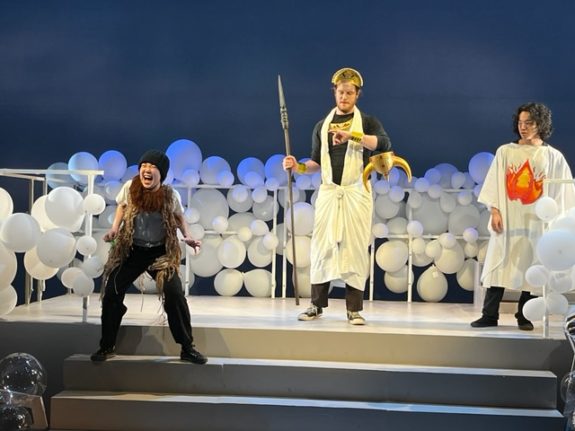
Alberich, Wotan, and Loge (post-Ring retrieval) 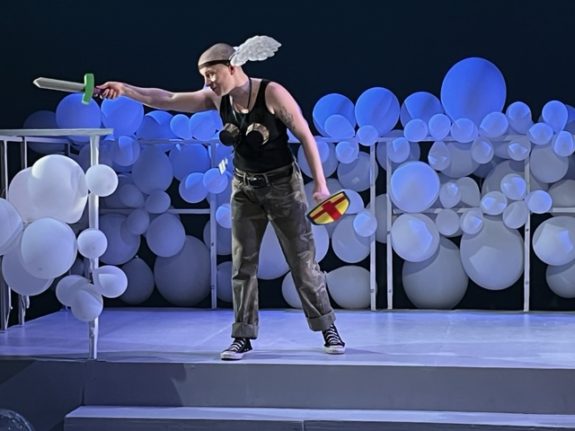
Brünnhilde is ready to fight! 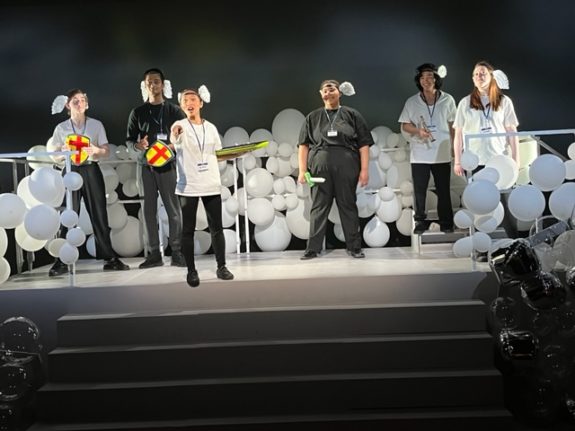
The rousing Ride of the Valkyries chorus (played on kazoos!) 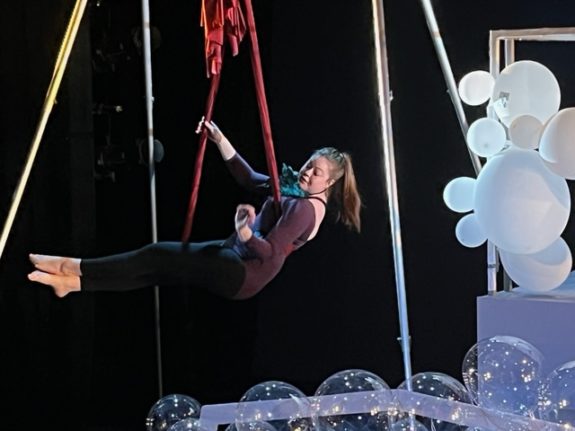
Sage Spitz as the Forest Bird (and trapeze artist!) 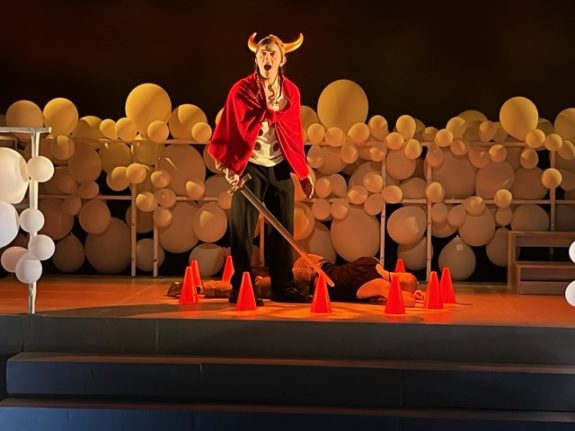
Siegfried about to awaken Brünnhilde 
Three sad Rhinemaidens in Götterdämmerung
Der Ring Gott Farblonjet poster via the Lenfest Center, all other images via Ava Slocum


 0 Comments
0 Comments